This site is made possible by its sponsors.
Please visit them!
sgraffito - A method of decorating or designing a surface, as of paint, plaster, slip (engobe), or glaze, by scratching through a layer of one color to expose a different color underneath.
As when :
Example:
![]()

![]()
China, Sung Dynasty, T 'zu Chou Vase, c. 1150, sgraffito design resulting in dark lines in white slip on stoneware.
Sgraffito is an Italian word literally meaning to scratch. The plural form is sgraffiti.
(pr. sgrə-FEE-toh)
Also see graffito, palimpsest, and slip-trailing.
shabtis - See ushabtis.
shade - A color to which black or another dark hue has been added to make it darker, tending to make them neutral in color. For example, black added to green makes it a darker shade of green. Value changes from pure hues are called shades and tints. You can see this in the color wheel below. On the right, pure hues are marked by dots. The shades made from those hues are under them.
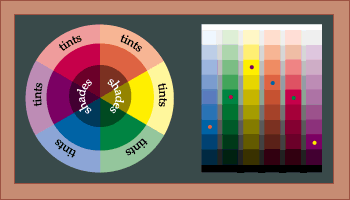
Opposite to shades in saturation — highly saturated, but just as low in lightness — are deep colors and may be tones. The opposite of shades in their value — much lighter in value, but just as low in saturation — are pale colors. Opposite to shades in both value and saturation are brilliant colors.
Other Internet resources concerned with shade:
Also see brightness, chiaroscuro, colorblind, gradation, gray scale, grisaille, light, monochrome, nocturne, nuance, saturation, shadow, tone, and tenebroso or tenebrism.
shading - Showing change from light to dark or dark to light in a picture by darkening areas that would be shadowed and leaving other areas light. Blending of one value into another is sometimes called feathering. Shading is often used to produce illusions of dimension and depth.
About shading:
"By adding darkness to the edge of
an object on the side that faces away from your light source,
you will push that edge away from your eye. If I had to choose
one of these twelve words that I thought was the most important,
I would choose shading. Shading is a power word for Ninja Power
Artists. With shading, you can make any drawing, even a flat
2-D picture, look super-three-dimensional! "
Mark Kistler,
American TV artist / instructor."The Twelve Renaissance
Words of Drawing in 3-D," 1997.
Also see chiaroscuro, gradation, modeling, penumbra, perspective, shade, and three-dimensional.
![]()

![]() shadow -
An area that is not or is only partially illuminated because an opaque
object is between the area
and the source of light. Or, the image cast by an object blocking
rays of illumination. Also, a faint indication, a vestige or remnant.
shadow -
An area that is not or is only partially illuminated because an opaque
object is between the area
and the source of light. Or, the image cast by an object blocking
rays of illumination. Also, a faint indication, a vestige or remnant.
Examples of works in which shadows are given prominence:
Rembrandt Harmensz. van Rijn (Dutch, 1606-1669), Self-Portrait at Twenty-Two , 1628, oil on panel, 22.6 x 18.7 cm, Rijksmuseum, Amsterdam, Netherlands. See Baroque, chiaroscuro, and Dutch art.
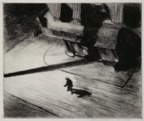
Edward Hopper (American, 1882-1967), Night Shadows, 1921, etching, proof,
6 7/8 x 8 1/4 inches (17.5 x 21 cm), San Diego Museum of Art,
CA. See American Scene painting.

Umbo (Otto Umbehr) (German, 1902-1980), Mysterium der Strasse, 1928, gelatin
silver print, 29 x 23.5 cm (11 7/16 x 9 1/4 inches), Metropolitan
Museum of Art, NY. See photography.

Andrew Wyeth (American, 1917-), The Pikes, 1965, watercolor, gouache and pencil
mounted on textured
card, 28 1/4 x 19 1/4 inches
(71.8 x 48.9 cm), San Diego Museum of Art, CA. See American
Scene painting.

Abelardo Morell (American, born Cuba, 1948-), Old Travel Scrapbook: Pyramids, 2000, photograph of a book opened so that a shadow cast on the book's interior echoes the triangular shape of the Egyptian pyramids in photographs on either side. Morell has made numerous photographs of books.

Ellis Gallagher (American, contemporary). Gallagher produces shadow art at night. In Brooklyn, he heads out on foot or on his bike with a backpack full of chalk, looking for shadows like this one (cast by a stop sign) to trace. When he tells you that "everything is fair game," he means it. He has traced everything from bicycles to whole city blocks. See an article about Gallagher and his shadow art in the New York Times, December 10, 2005.
Quotes about shadow:
"When you draw darkness on the ground next to the shaded side of an object, you will create the illusion that the object is really sitting on the ground. There are several types of shadows we will be learning in the lessons." Mark Kistler, American TV artist / instructor. "The Twelve Renaissance Words of Drawing in 3-D," 1997.
"What is the speed of dark?" Steve Wright, contemporary American comedian.
Internet resources concerned with shadow:
Also see chiaroscuro, crepuscular, gradation, light, modeling, opaque projector, penumbra, perspective, shade, shading, tenebroso or tenebrism, and three-dimensional.
![]()
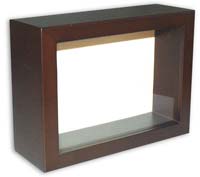
![]()
shadow box - A frame that is deep enough to accomodate a three-dimensional object, deeper than frames needed for two-dimensional works, or for three-dimensional ones that are very shallow. Typically shadow box is faced with transparent glass, Plexiglas, etc.
Examples:
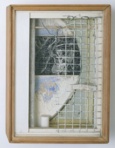
Joseph Cornell (American, 1903-1972), Central Park Carrousel, in Memoriam. 1950, shadow box construction with wood, mirror, wire netting, and paper, 20 1/4 x 14 1/2 x 6 3/4" (51.4 x 36.8 x 17.1 cm), Museum of Modern Art, NY. See sculpture and Surrealism.
Joseph Cornell, Suzy's Sun (for Judy Tyler), 1957, mixed-media shadow box construction, 10 3/4 x 15 x 4 inches (27.3 x 38.1 x 10.2 cm), North Carolina Art Museum, Raleigh.

![]()

Marek Cecula (American, born Poland, 1944-),
Shard,
1998, authentic porcelain shard,
plaster, wood, glass,
14 x 14 x 2.5 inches, Grand Arts, Kansas City, MO. Roberta Lord,
of Grand Arts wrote, "In 1979, visiting his Polish homeland
for the first time in 25 years, Marek Cecula was strolling with
his sister along a Baltic beach when he spotted a small white
object half-buried in the sand. He picked it up and saw that
it was a piece of a ceramic plate bearing the factory's back
stamp, or 'maker's mark.' The mark in this case was a swastika.
Cecula, a self-exiled Polish Jew who has made ceramics his life's
work, and whose father was interned in Dachau, held in his hand
the identifying fragment of a piece of dinnerware manufactured
for the Nazi party. For his 2000 exhibition Violations,
he formed a white plaster 'ghost plate' around the stamped piece
and mounted it in a plain birch box with a glass face."
See hallmark.
Also see base, bin, Kunstkabinett, Kunstkammer, niche, shadow, vitrine, Wunderkabinett, and Wunderkammer.
shaft - A spear or an arrow, or something suggestive of those shapes, such as a long pole, a long handle of a tool, the central member of a feather, a deep pit, etc. In architecture, the part of a column between the capital and the base.
Examples:
Columnar shafts as they figure into a diagram of the Doric order and a diagram of the Ionic order.
Also see abacus, architrave, classical orders, Corinthian, cornice, Doric, echinus, entablature, frieze, Greek art, Ionic, metope, orders, Roman art, shaft, stylobate, and triglyph.
shaft grave - A grave in the form of a deep pit, the actual burial spot being at the base of the shaft or in a niche at the base.
shakudo - In Japanese tradition, an alloy of copper, with about 2-5% gold.
Example:

Ishiguro Masayoshi (Japanese, 1772-after
1851), Sword Guard (Tsuba), 19th century, Edo period, shakudo, gold, shibuichi,
copper, Metropolitan Museum of Art,
NY. See arms
and armor.
![]()
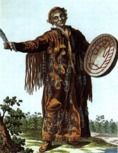
![]() shaman
and shamanism -
A shaman is a priest or medicine man who (purportedly) can influence
good or evil spirits. Shamanism is an archaic magico-religious
phenomenon in which the shaman
is the great master of ecstasy. The cultures
in which shamanism has been noted include those of various Stone Age, Siberian, Mexican,
American Indian, Inuit, and
Australian Aboriginal peoples.
The activities of shamans are occasionally compared to those of
visual artists in non-shamanic
cultures.
shaman
and shamanism -
A shaman is a priest or medicine man who (purportedly) can influence
good or evil spirits. Shamanism is an archaic magico-religious
phenomenon in which the shaman
is the great master of ecstasy. The cultures
in which shamanism has been noted include those of various Stone Age, Siberian, Mexican,
American Indian, Inuit, and
Australian Aboriginal peoples.
The activities of shamans are occasionally compared to those of
visual artists in non-shamanic
cultures.
(pr. SHAH-mən or SHAY-mən)
Also see amulet, ex voto, fetish, metal, milagro, mystery, talisman, and votive.
shamsa - See bookplate or ex libris.
Shang - A Chinese dynasty which lasted c. 1600 - 1050 BCE Mask-like designs with protruding eyes (taotie), are the dominant Shang decorative motif.
Examples of work of the Shang dynasty period:
China, Ritual Wine Container (Fang I), Shang
dynasty, 15th-13th century BCE,
bronze, inscribed inside with two characters, Worcester Art Museum,
MA. Masklike designs
with taotie appear on each side
of the vessel
and the front and back of its roof.

China, Henan province, possibly Anyang, Spouted Ritual Wine Vessel (Guang), Shang
dynasty, early Anyang period (c. 1300 - c. 1050 BCE),
13th century BCE,
bronze, width 13 inches (33 cm), Metropolitan
Museum of Art, NY.

China, Ritual Wine Container (Yu), Shang dynasty,
11th century BCE,
bronze, inscribed inside with one character, Worcester Art Museum,
MA.
shank - The whole of a leg; or the whole of a piece of type exclusive of the printing surface; or the long, slender shaft of a nail.
shape - An element of art, it is an enclosed space defined and determined by other art elements such as line, color, value, and texture. In painting and drawing, shapes may take on the appearance of solid three-dimensional object even though they are limited to two dimensions — length and width. This two-dimensional character of shape distinguishes it from form, which has depth as well as length and width.
Examples of shapes include: circle, oval, and oblong; polygons such as triangle, square, rectangle, rhombus, trapezium, trapezoid, pentagon, hexagon, heptagon, octagon, nonagon, decagon, undecagon, dodecagon, etc.; and such other kinds of shapes as amorphous, biomorphous, and concretion.
Also see angle, curve, edge, egg-and-dart, flat, fold, French curve, letterform, manipulate, memory, obverse and reverse, positive and negative space, radial, straight, structure, surface, and vertex.
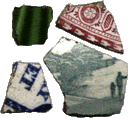
shard - A potsherd,
a piece or fragment of broken
pottery.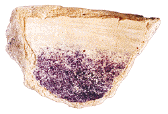
Also, any small part of something, especially when made of a brittle substance, such as glass. This word is sometimes spelled "sherd," and pronounced that way too.
Artists have used shards as a found material in making works of various kinds, as in the making of pique assiette (also called picassiette) and trencadis, which are techniques of mosaic or tiling using shards.
Examples:

Enough shards from a broken pot were found,
arranged, and assembled to produce a reconstruction of the pot. This use of
shards is often made by archaeologists.
Also see adhesives, art
conservation, and restoration.
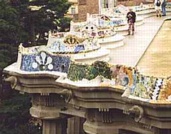
Antoni Gaudí (Spanish, 1852-1926)
and Josep Maria Jujol (Spanish, 1879-1949), the serpentine bench
at Güell
Park (Parc Güell), 1900-1914, trencadis,
Barcelona, Spain.
![]()

![]()
![]()
Telephoto
shot of the top of the bench.

![]()

Details of the bench.
See serpentine and telephoto.

![]()

Marek Cecula (American, born Poland, 1944-),
Shard,
1998, authentic porcelain shard, plaster, wood, glass, 14 x 14 x 2.5 inches, Grand Arts,
Kansas City, MO. Roberta Lord, of Grand Arts wrote, "In
1979, visiting his Polish homeland for the first time in 25 years,
Marek Cecula was strolling with his sister along a Baltic beach
when he spotted a small white object half-buried in the sand.
He picked it up and saw that it was a piece of a ceramic plate
bearing the factory's back stamp, or 'maker's mark.' The mark
in this case was a swastika. Cecula, a self-exiled Polish Jew
who has made ceramics his life's work, and whose father was interned
in Dachau, held in his hand the identifying fragment of a piece
of dinnerware manufactured for the Nazi party. For his 2000 exhibition
Violations, he formed a white plaster 'ghost plate' around
the stamped piece and mounted it in a plain birch box with a
glass face." See hallmark,
Polish art, and shadow
box.
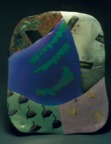
Patrick Shia Crabb (American, contemporary),
Shard
Plate, from the "Shard Plate" series, 2002,
glazed slab
constructed stoneware,
fired by raku
and electric kiln, 22 x 18
x 3 inches, collection of Dona Rosa Farrell. Detail. The artist has said, "The Shard
Plates series were derived from my fascination [with] the
American Southwest's Native American culture. Pottery shards
can be easily found along hiking trails, providing fascinating
details of artistry. These wonderful patterns are now part of
the images of each shard on the plates. The plates are intentionally
broken, designed, fired, and finally reassembled with glue — somewhat like a pattern on a cloth quilt." See numererous
examples of pots Crabb produced this way on his site.
Patrick Shia Crabb, Shard Plate 1, from the "Shard Plate" series, glazed slab constructed stoneware, fired by raku and electric kiln, 2003.
Also see lacuna, ostracon, and void.
shawabtis - Alternative spelling of ushabtis.
sheen - A glossy, lustrous surface, such as found on satin.

![]()
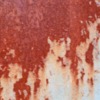
![]()
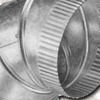 sheet
metal - Metal that has
been flattened or rolled,
and can then be cut, bent, joined,
and otherwise formed, and perhaps coated
or patinated. See the names
of various metals, charts
of steel sheet gauges, jewelry,
sculpture, the names of various
twentieth century style (such as Minimalism), and the names of various
techniques (such as riveting
and welding).
sheet
metal - Metal that has
been flattened or rolled,
and can then be cut, bent, joined,
and otherwise formed, and perhaps coated
or patinated. See the names
of various metals, charts
of steel sheet gauges, jewelry,
sculpture, the names of various
twentieth century style (such as Minimalism), and the names of various
techniques (such as riveting
and welding).
Examples of works in sheet metal:
Pablo Picasso (Spanish, 1881-1973), Guitar. 1912, sheet metal and wire construction, height 30 3/4 inches, Musée Picasso, Paris. Here the potential of cubism for sculpture became fully realized. See assemblage, construction, cubism, and sculpture.
![]()

![]()
H.C. Westerman n (American, 1922-1981), Billy Penn, 1976, pine, galvanized
steel, sheet metal,
bronze, and
metallic paint, 79 1/4 x
42 1/2 x 29 5/8 inches (201.3 x 108 x 75.2 cm), Museum of Contemporary
Art, Chicago.

Richard Deacon (English, 1949-), If The Shoe Fits, 1981, galvanized
steel, 160.0 x 325.0
x 184.0 cm, Tate Gallery, London. See Post-Minimalism.
Also see boss, die, filigree, foil, gauge, galvanized, glitter, guillotine, leaf, patina, patinate, patination, repoussé, pitch, rivet, rust, and texture.
shellac - Lac is a resinous substance secreted by the lac insect, and found on trees in southeast Asia. It is melted into plates (which resemble shells) and used in the manufacture of a varnish which provides a golden translucent finish that darkens with age. Shellac has been used most frequently as a coating on wood, but also on bronzes and plaster cast. It can be toned with various pigments. Shellacs are available with a matte, semi-gloss, or glossy finish.
Also see lacquer and polyurethane.
sherd - See shard. Also see potsherd.
shibuichi - In Japanese tradition, an alloy of copper and silver.
Example:

Ishiguro Masayoshi (Japanese, 1772-after
1851), Sword Guard (Tsuba), 19th century, Edo period, shakudo,
gold, shibuichi,
copper, Metropolitan Museum of Art,
NY. See arms
and armor.
shim - A thin brass strip used to divide the surface of a modeled sculpture into sections for a piece mold.
Also see pixel shim.
shin - In Japanese tradition, a calligraphic term referring to formal or static brushstrokes. Also see gyo, Japanese art, shuji, and so.
Shinto - The indigenous faith of the Japanese people. Also see Buddhist art, chigi, and Japanese art.
Shiva or Siva - In Hindu belief, one of the principle deities, worshiped as the destroyer and restorer of worlds, and in numerous other complementary forms. Shiva is often conceived as a member of the triad including Brahma and Vishnu; or with his wife Parvati, and his sons Skanda and Ganesha. He is often portrayed holding an ax (symbol of his power) and an antelope (symbol of his rule over the beasts of the wilderness). Others of his attributes are the trident, the third eye, the flask, prayer beads, and the fly-whisk.
(pr. SHEE-və)
Example images of Shiva:

India, c. 950, Siva as the Lord of Dance (Nataraja),
copper alloy,
30 x 22 1/2 x 7 inches (76.2 x 57.1 x 17.8 cm), Los Angeles County
Museum of Art. See dance.
Nepal, c 1000, Androgynous Form of Siva and Uma, copper alloy with semiprecious stones, 33 x 14 1/2 x 5 inches (83.8 x 36.8 x 12.7 cm), Los Angeles County Museum of Art.

India, Tamil Nadu, Shiva as Lord of Dance (Nataraja), Chola
period (880-1279), c. 11th century, copper
alloy, height
26 7/8 inches (68.3 cm), diameter
22 1/4 inches (56.5 cm), Metropolitan Museum of Art, NY.

South India, Chola dynasty, Somaskandamurti, 11th-12th century, bronze, Worcester
Art Museum, MA. Somaskandamurti is a manifestation of Shiva,
seated on Mount Kailasa, the mountain throne of the gods. The
multiple aspects of Shiva are combined in three personages: the
god himself, his consort Parvati, and his son Skanda. This type
of representation is peculiar to South India, where it originated
during the Pallava period (about fifth to ninth century).

India, Maharashtra or Karnataka, South Asia,
Mask of Shiva, 18th century,
repoussé silver, 9 7/8 x 6 7/8 x 2 1/2 inches (25.08 x 17.46 x 6.35 cm), Los Angeles County Museum of Art. See mask.
Also see creativity and destruction.
![]()

![]()
shoji - In Japanese architecture, a translucent rice-paper-covered sliding screen that serves as a room divider in traditional Japanese houses.
(pr. SHOH-jee)
![]()

![]()
shuji - In Japanese tradition, a form of sacred, phonetic writing.
(pr. SHOO-jee)
Also see calligraphy, chop, gyo, Japanese art, lettering, pictograph, seal, shin, Shinto, so, and sumi-e.
https://inform.quest/_art